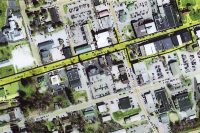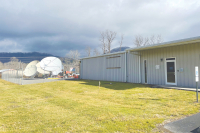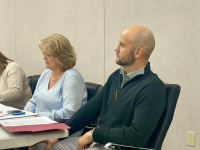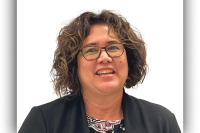The tricky terrain of Native American labels
 Diamond Brown has perfected the art of bait and switch.
Diamond Brown has perfected the art of bait and switch.
He hooks his unsuspecting subjects with an eye-catching spread of indigenous tools — arrows and adzes, bone awls and baskets, pelts and pestles.
They edge closer, riffling through their pockets or purses for a camera, then raising it timidly as they scan the other onlookers, not quite sure what the protocol is for photographing a Cherokee man wearing nothing but a tanned hide around his waist.
Brown soon loosens them up with a joke, a story, a punch line or two. But before they know it, they have stumbled headlong into a lesson on Cherokee culture and history.
“If you want entertainment, go over there,” Brown told the audience amassed around his prototype of a historic Cherokee encampment.
Related Items
He pointed to the stage on the other side of the Cherokee Fairgrounds filled with drum beats and costumed dancers appearing in the Festival of Native Peoples. But no one made a move to escape, despite Brown’s declaration that what they were about to get from him was “an education.”
Brown has spent three decades on the guest speaker circuit educating whites and non-natives about what it means to be Cherokee. Most of that time was in Atlanta, delivering his message to thousands of school children during the years.
In the 1980s, kids often greeted him with a raised palm while uttering “How” and showed off their skills at sitting Indian style.
“Indian style? What’s that? If you were sitting back in your recliner with your feet up, and a remote control in your hand, then OK, that’s Indian style,” Brown quipped, a signature form of dark humor that often makes its way into his programs.
Despite Brown’s life work on the front line of a movement to re-calibrate America’s perception of native people, he didn’t expect to actually see the fruits of his labor come to pass so soon.
“I thought it would be my kids or grandchildren that would see that shift happen. It really knocked me over that I was able to see that in my lifetime,” Brown said.
Today, it’s rare that Brown is ever greeted with a “How.” And school children draw a blank if told to sit “Indian style.” Instead, the cross-legged posture is known ubiquitously by youth as sitting “criss-cross applesauce.”
Perhaps the most notable change: the word “Indian” being tossed out in favor of Native American.
The 1990s brought on a new wave of political correctness and cultural sensitivity for all ethnicities. The advent of Native American rode the same wave as terms like African American and Asian American.
But challenging assumptions is what Brown does best, and lately he’s been asking a new question: how accurate is the term Native American?
“I have always had a problem with being called Indian — and even being called Native American,” Brown said.
To drive the point home, he picked a guinea pig from the audience corralled around him at the Cherokee Fairgrounds.
“Who’s lived in the same state all their life?” Brown asked.
Hands shot up. The honors went to a woman from Florida, who was asked three basic questions.
Did she consider herself a Native Floridian? Yes, she said.
Is Florida in the United States of America? Well, yes, she said, but now growing hesitant that Brown was laying a trap.
If she is a native Floridian, and Florida is in America, doesn’t that make her a Native American?
“Anyone who is born in America is a Native American,” Brown said.
Brown admits Native American is a step up from Indian, a label leftover from Christopher Columbus who thought he’d landed in India.
But Native American isn’t much better, Brown contends.
On one hand, Native American just isn’t accurate, since it technically describes anyone born here. And it doesn’t encompass native people from Alaska or Hawaii.
But at its core, it’s a namesake of the Italian explorer Amerigo Vespucci.
“He mapped these two continents and so they named these two continents after him. And now we have been tagged and named after another man,” Brown said.
It’s more of the same — an inaccurate label assigned entire nations of people by outsiders.
When in doubt, ask
What to call Native Americans — a single sweeping term to refer to the hundreds of tribes acting as nations unto themselves before the arrival of Europeans — is a philosophical one, with no single right answer.
“A lot of that does have to do with a matter of opinion,” said Mike Littlejohn, the collections manager at the Museum of the Cherokee Indian in Cherokee.
The subject even has a prolific Wikipedia entry dedicated to it under the banner “Native American Name Controversy.”
There’s a common denominator in the debate: almost any term is going to have potential landmines associated with it.
“It is always going to be precarious because you are trying to say a whole bunch of things that don’t make any sense,” said Tom Belt, a Cherokee linguist and Cherokee language instructor at Western Carolina University. “Suffice it to say, it has caused a whole lot of discussion. Everyone is wanting to be politically correct in some form or another.”
The most accurate — and most preferred by native people — is to use the name of their individual tribe.
“It is a matter of personal identity is what it boils down to,” said Dennis Zotigh, a cultural specialist at the Smithsonian’s National Museum of the American Indian “All native people are fiercely proud of their tribal affiliations. If someone incorrectly called them a tribe that they weren’t, they would be very quick to correct them. ‘I am not that tribe; I am this tribe.’ That personal identity is a very strong identify.”
If you don’t know someone’s tribe, just ask, Zotigh said.
“It should be protocol for when you meet a native person for the first time to ask them. We should start training Americans to do that,” Zotigh said. “Otherwise, we are lumped in a very broad general group. If you do that, you dismiss the histories and diversity of Indian people.”
Belt agreed it’s preferable to refer to a native person by their individual tribe. But even that carries its own set of baggage and is not always accurate. Native people were often labeled by settlers and explorers with names other than what a tribe actually called themselves.
“We all knew who we were and had our own names for ourselves. But most of the tribes have names that were imposed on them,” Belt said.
Sioux is the most oft-cited example. Sioux is thought to actually be a derogatory term meaning “snake” used by the rivaling Ojibwa for the Dakota and Lakota people. But when explorers asked the Ojibwa what the neighboring tribe was called, it went down in history as the Sioux.
Now, the Lakota, Dakota and Nakota people prefer those distinct tribal references and have shed the name Sioux. They are even actively working to change the official geographic place names that bear the word Sioux, such as the Sioux River, citing the appearance of Sioux over and over on maps as derogatory and insulting.
In that vein, Cherokee is technically not what the Cherokee people called themselves. Hernando de Soto picked up the name Cherokee from a tribe to the east.
“We got stuck with it. It isn’t even our tribal word,” Belt said.
Cherokee people called themselves Kituwah. Some Cherokee people have again taken to calling themselves Kituwah — indeed, Cherokee who held on to their native language never quit — but a tribal-wide shift would be a likely insurmountable task, Belt admitted.
Getting technical: tribe or nation?
Before you go asking a native person what tribe they belong to, however, Brown offered up even more food for thought. Is the word “tribe” even technically correct?
Native peoples were actually functioning as their own nations, operating with distinct languages and sophisticated political structures across vast territories. The word tribe is an understatement, carrying the connotation of wandering nomadic bands.
“Before the explorers came, we had nations of different people with their own governments, languages and cultures. Those are nations of people,” Brown said.
After all, if someone was of Irish or German ancestry, you wouldn’t say they are from the Irish tribe, or from the German tribe.
So instead, Brown suggested, ask a native person “Who are your people?”
“And they would say, ‘I’m Cherokee,’” Brown said.
For Zotigh, however, the answer would be even more complicated. He’s Kiowa, Santee Dakota, and Ohkay Owingeh Pueblo. It’s a mouthful, even for a native person who’s used to speaking in such circles.
And thus, sometimes, a singular term to refer broadly to all native people is a necessity.
Zotigh personally prefers American Indian. Mostly because he’s accustomed to it, just as the generations before him had adopted the word Indian and made it their own.
“My grandparents’ and parents’ generation were perfectly fine with being called Indian. They didn’t think anything of it, and I don’t think anything of it,” Zotigh said. “For people of your generation, it became politically correct to say Native American. But for my generation, it was American Indian.”
Indeed, the term American Indian was chosen by the Smithsonian for its flagship museum celebrating native cultures — the National Museum of the American Indian.
But to Brown, American Indian is a two-fold misnomer. It borrows from the name of Italian explorer Amerigo Vespucci and the false label from Columbus to boot.
There’s an argument to be made for the term American Indian, however.
“American Indian is still the language of the law,” Zotigh said.
There’s the Bureau of Indian Affairs, the Indian Child Welfare Act, the Indian Health Service, National Congress of the American Indians, National Indian Education Association, and so on, Zotigh pointed out.
In Canada, native people are collectively and officially known these days as “First Nation.” It pays homage to the fact they were living on this land first, and to the fact that they were their own nations.
“I kind of like that. It doesn’t say America and has no political overtones,” Zotigh said.
To each his own
To Brown, it’s a huge step that society is even engaging in a wide-scale discussion of the preferred and proper term for native people.
Brown told the audience gathered around his encampment at the Festival of Native Peoples last month to take note of the festival’s name — native people. Native people, or simple native, is growing in popularity as the preferred point of reference.
Across the fairgrounds from Brown on the official performance stage, the emcee for the festival was filling airtime while the next set of dancers was queuing up, and he, too, touched on the subject.
“We don’t get hung up on titles. Native American, American Indian. It doesn’t matter. We know who we are,” Osceola Redshirt told the stadium full of people waiting for the next show. But, “We like to call each other Native.”
Zotigh said it was too soon for him to weigh in on whether America was witnessing a collective shift from the term Native American to simply “native,” and whether in 20 years it’s what we would all be saying.
“I hate to make any predictions that far in the future because something new might come along,” Zotigh said.









